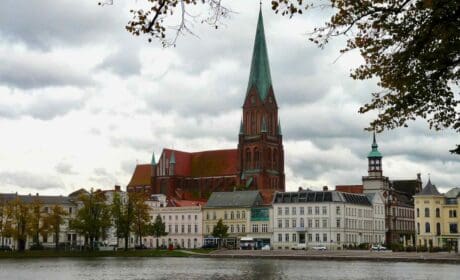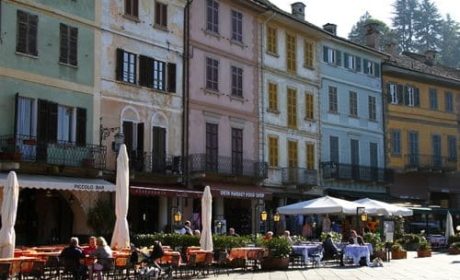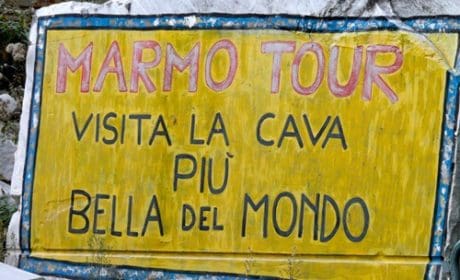Are you looking for a Berlin day trip that’s sort of off-the-beaten-path? The grandeur of Sanssouci is only a train ride away.
My Itchy Travel Feet featured writer, Debi Lander of ByLanderSea, reports on her day trip to Sanssouci, sharing her experience and tips for seeing the UNESCO site’s palaces and parks. Create an independent Berlin to Potsdam day trip with Debi’s tips!
In London, it’s Buckingham Palace, and near Paris, it’s Versailles, but many don’t know of the opulent Sanssoucci near Berlin. It’s a monumental estate in Potsdam with interiors on par with Buckingham or Windsor Palace and extraordinary gardens such as those at Versailles.
On a visit to Berlin, I made an easy day trip to Sanssouci via a local commuter train to Potsdam. The 30-mile journey takes 40 minutes due to many stops. Local buses and taxis wait just outside the train station in Potsdam.
I knew I was headed for a good day because Sanssouci is part of the designated UNESCO World Heritage site in Potsdam that extends into the district of Berlin-Zehlendorf. (In my opinion, UNESCO sites don’t disappoint.) The official designation is Palaces and Parks of Potsdam and Berlin.
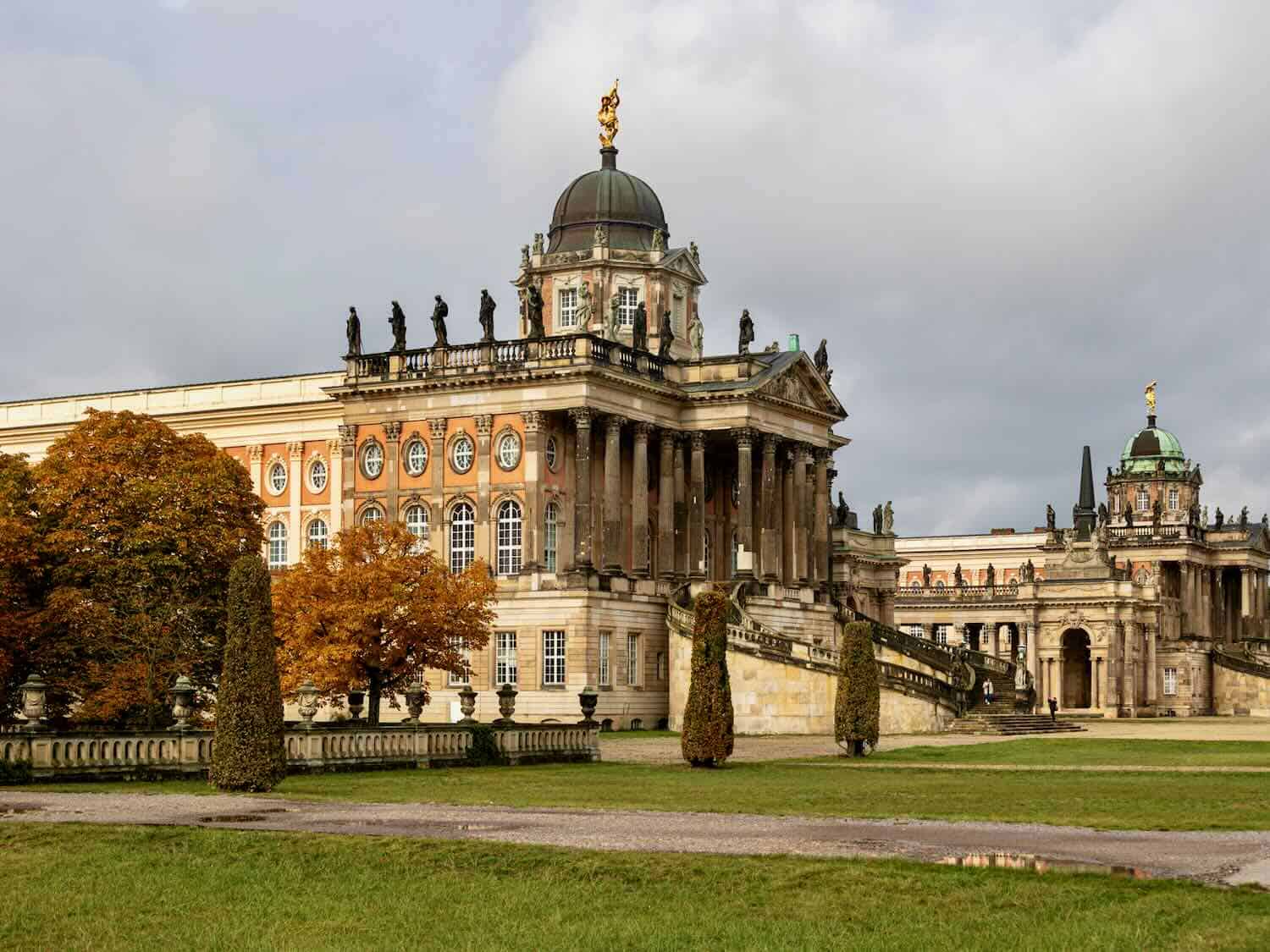
Be prepared: The place is enormous; I found it impossible to see everything in one day. I suggest you start at the original mansion (named Sanssouci) built by King Frederick II between 1745 and 1747.
I admit I knew nothing about this king, who was considered Frederick the Great (1712 – 1786), but I learned he had a passion for classical music, philosophy, culture, and art. The king was famously humble and is epitomized in his saying, “A crown is merely a hat that lets the rain in.” I like that.
He sketched the structure himself and named it Sanssouci, based on the French phrase ‘sans souci’ meaning ‘without worry.’ The king’s summer residence ultimately became his favorite retreat (especially in the company of his dogs) and a sanctuary in difficult times.
Table of Contents
Touring the original Sanssouci Palace
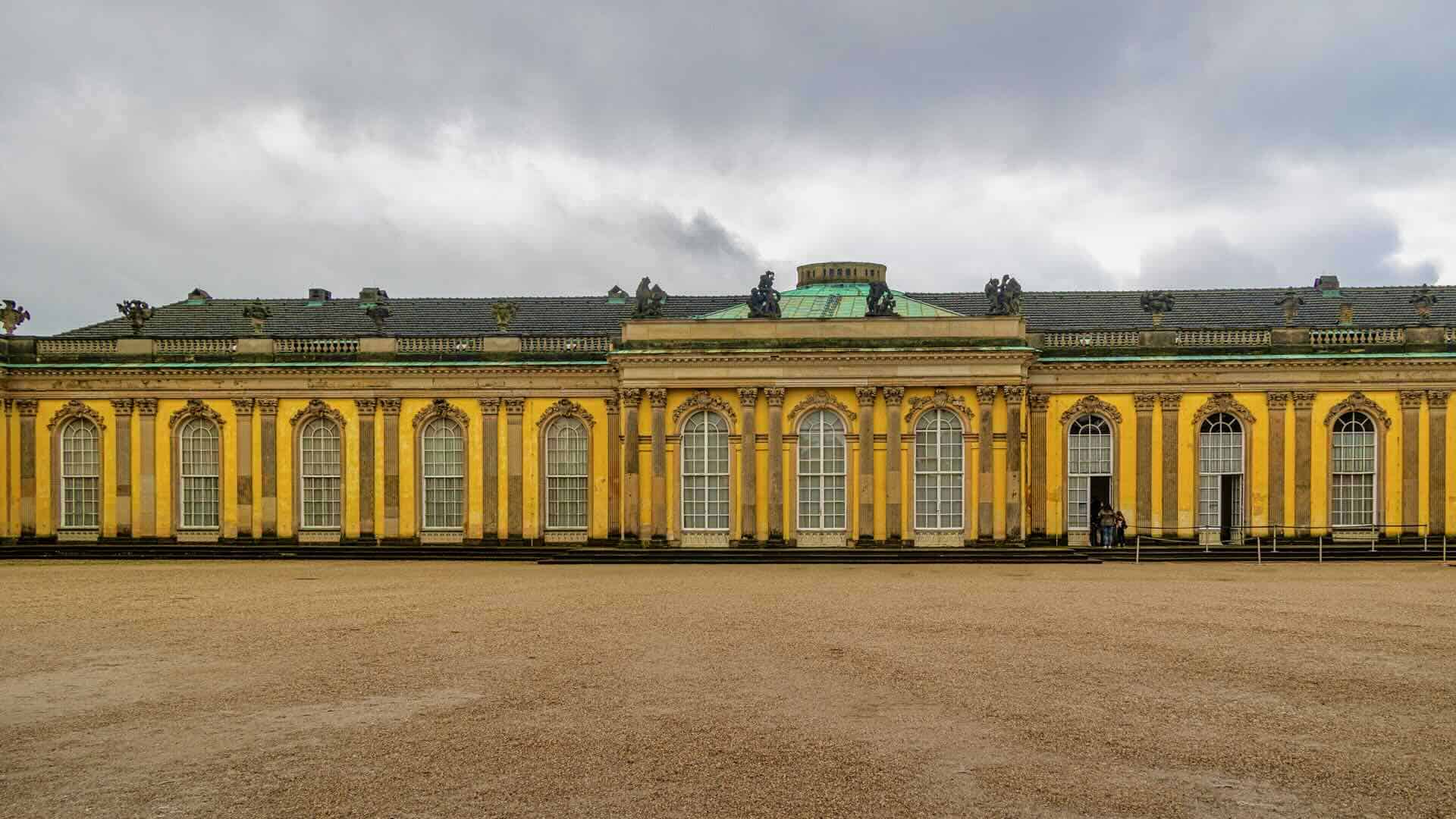
The 12-room Baroque and Rococo-style single-story palace is small by royal standards but is definitely not modest. (I remember Baroque architectural style by saying, baroque—choak. The décor is usually over-the-top gaudy to me.)
A more classical style shines through in the columned walls, tall arched windows, and a central ballroom featuring a large green dome. The building rests at the top of a multi-level terraced vineyard. Standing at the bottom of the terrace reminded me of another extravagant venue: Peterhof in St. Petersburg, Russia.
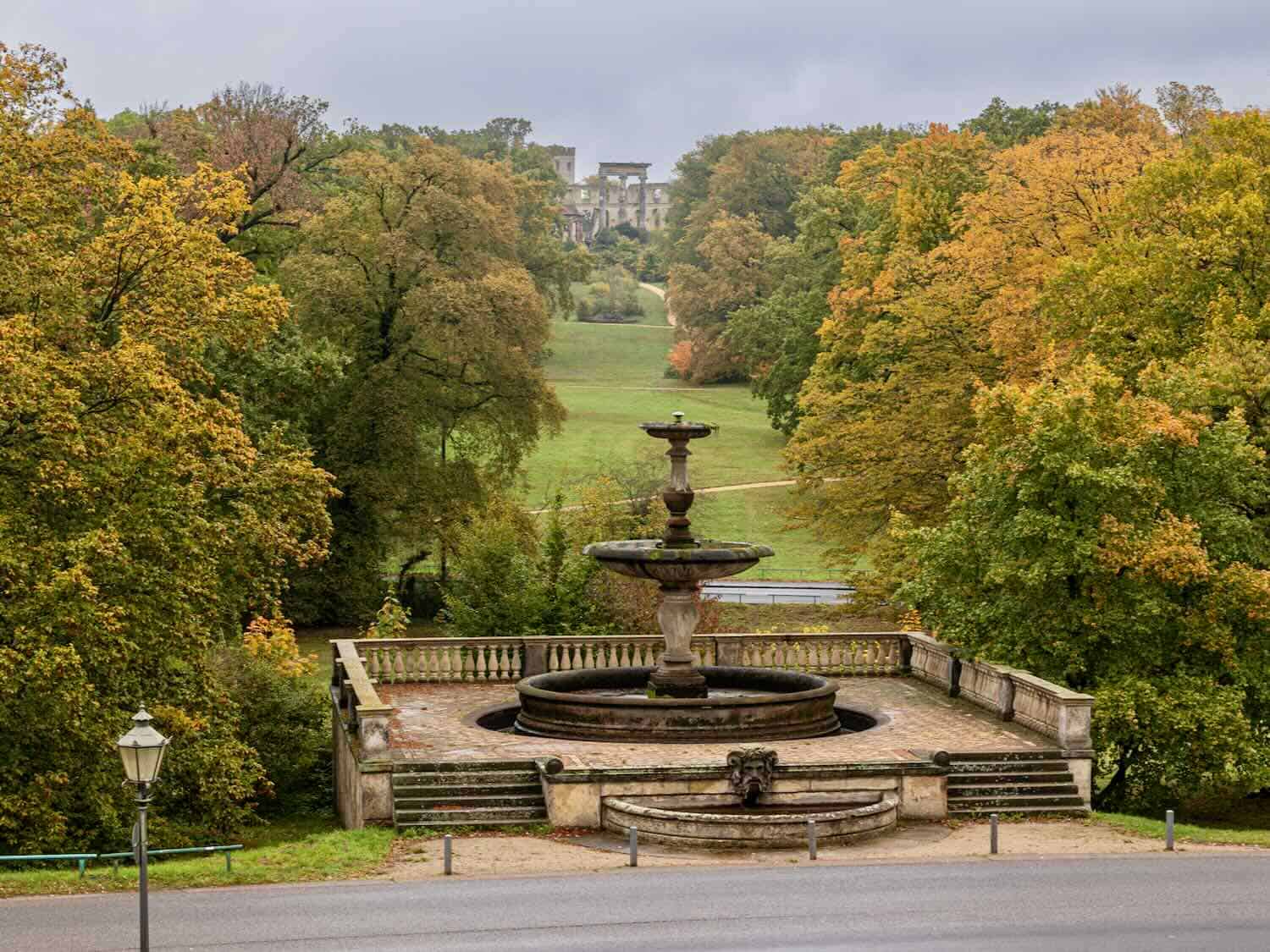
While the main palace building is comparatively small, the park (Sanssouci Park) surrounding the complex covers 741 acres of manicured landscape with formal gardens, colonnades, fountains, and statuary. My travel buddy and I entered through the gardens (by mistake, but they are free admission and fabulous). I suggest you wear your most comfortable and supportive shoes because we walked our feet off.
Visitors to Sanssouci Palace enter through a rather small doorway and can pick up an audio/headset tour (it’s excellent). Inside, you’ll see original 18th-century interior furnishings. They clearly express the king’s love of beautiful surroundings.
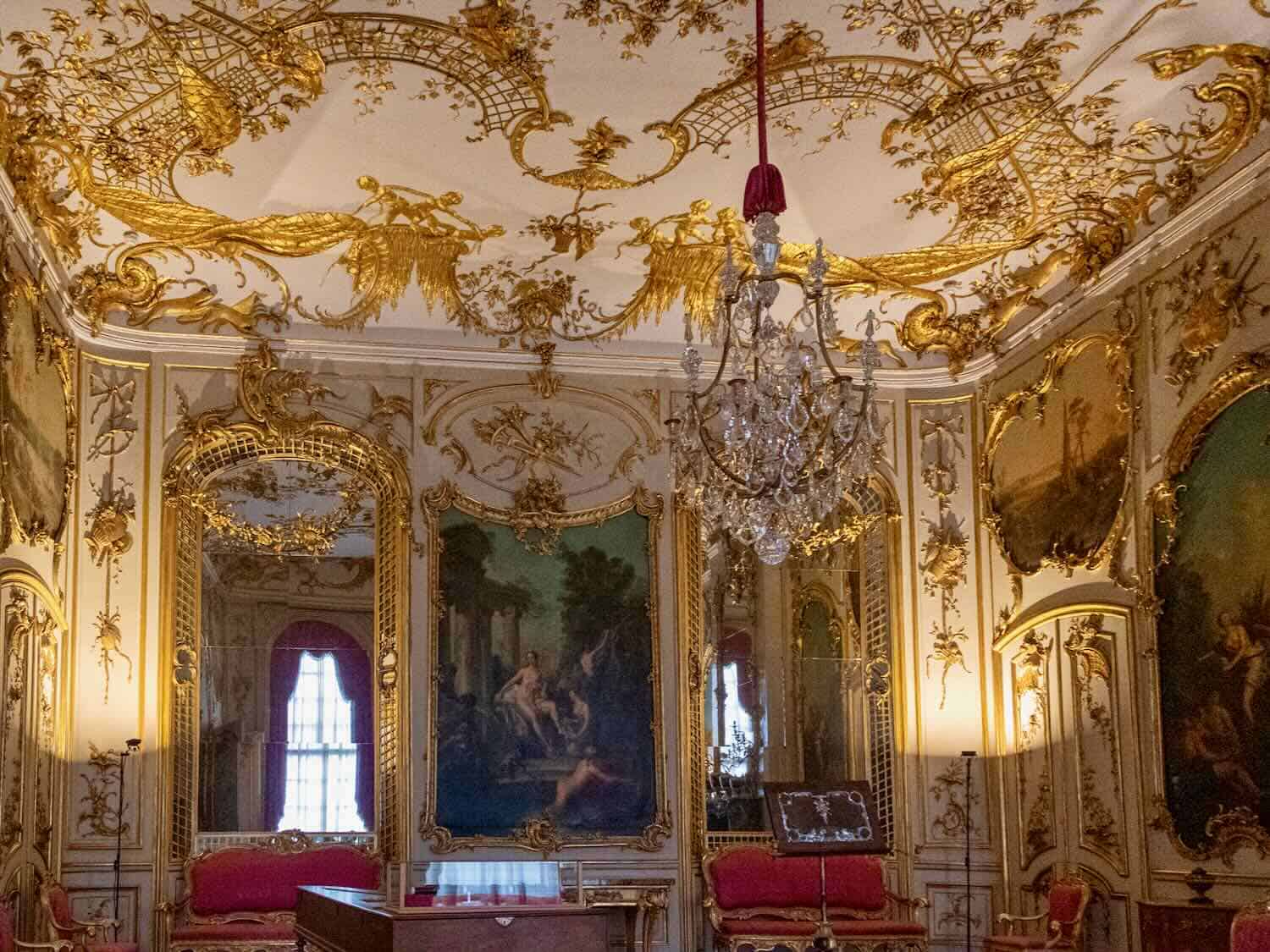
Many of the ceilings feature gold-leaf decoration around the moldings. The ceiling in the domed room was incredibly ornate. Some rooms had a small bed tucked into the wall and hundreds of paintings hang everywhere.
I liked the room showcasing 3-D reliefs with jungle-themed animals and plants (I think it was the music room). Overall, the palace feels like a very wealthy, overly decorated home, but somehow not too stuffy.
In 1841, King Friedrich Wilhelm IV expanded the Sanssouci Palace to include a western ladies’ wing and an eastern side wing for the kitchen and wine cellar.
The king wished to be buried in a crypt on the uppermost terrace of the vineyard. However, his wish wasn’t granted until his reburial there after German reunification in 1991.
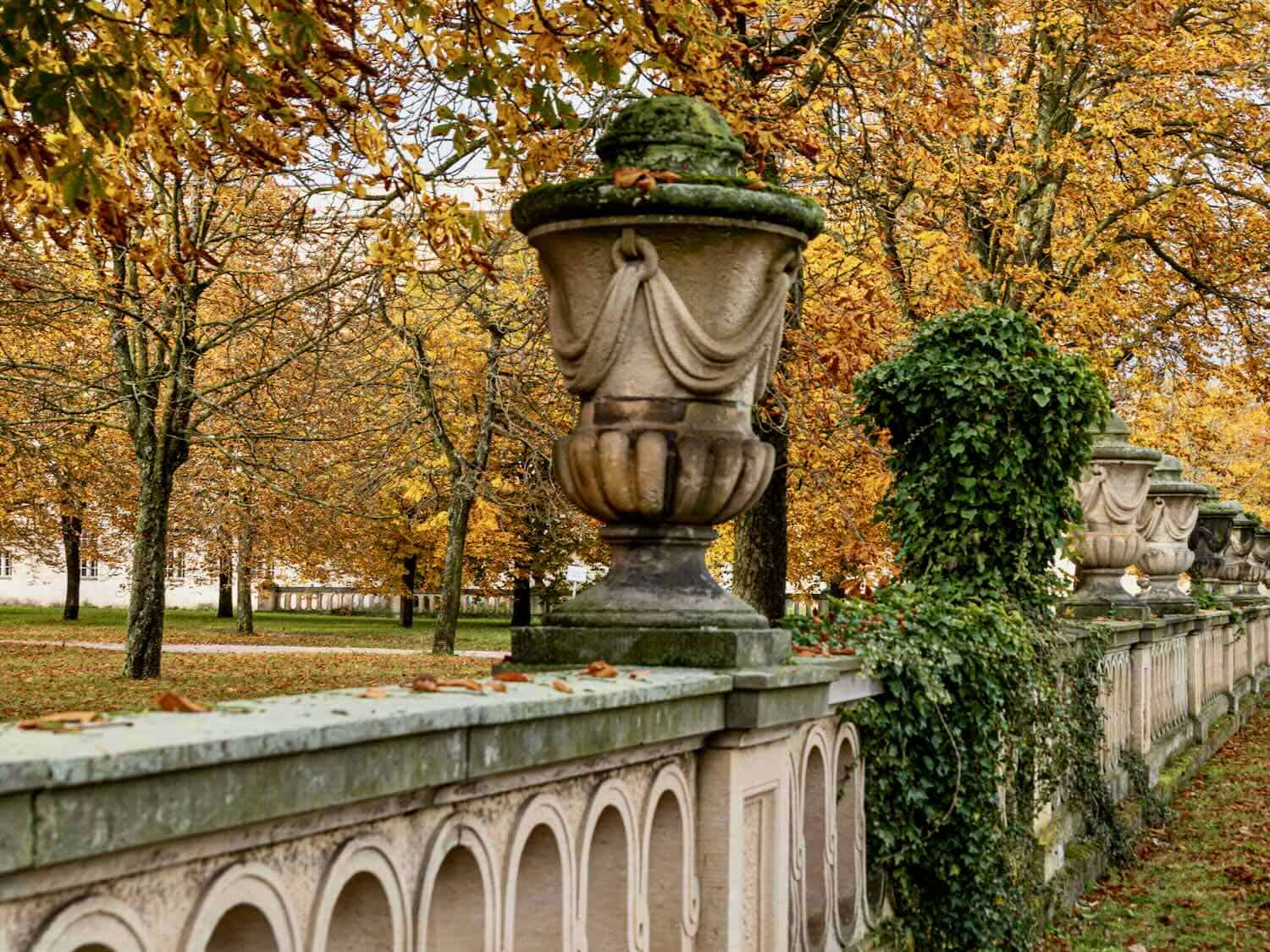
After we exited Sanssouci, we browsed the vineyards and made our way to the windmill. We had a snack in the café and then realized the Visitor Center was across the way. (Go there when you first arrive!)
The historic mill at Sanssouci was built in 1737 before the palace in 1745. This mill remained private until its sale to the German crown in 1861.
At the Visitor Center, we learned about a shuttle bus that would take us to the New Palace, a mile away, so we hopped on. We passed the Orangery Palace during the ride, a site I would have enjoyed if we’d had the time. (We didn’t.)
However, if you are interested, the Orangery was the last and largest palace building constructed in Sanssouci Park. It is an impressive example of the buildings erected by Frederick William IV. The imposing structure with its plant halls, central palace, sculptures, fountains, arcades, and terraces evoke Frederick William IV’s love of Italy.
Explore the opulent New Palace
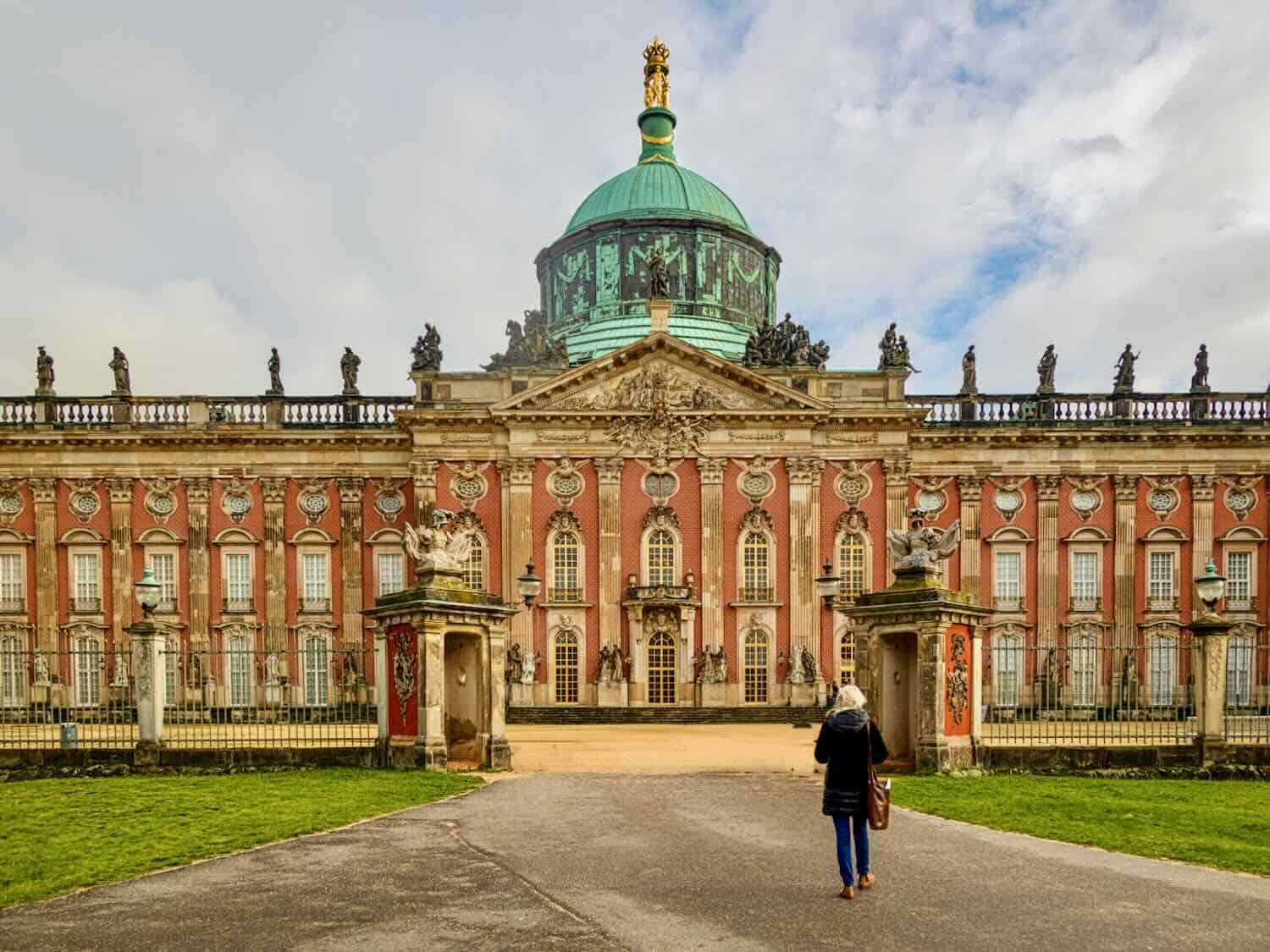
We approached the New Palace in awe. This structure was colossal, and (believe it or not) another two similar but slightly smaller palace-like buildings rest across the main promenade. They were used for servants. Over 400 sandstone statues and figures adorn the palace and auxiliary buildings, created by many notable sculptors.
The New Palace was erected from 1763 until 1769 to show off the power of Fredrick the Great after the Seven Year’s War. It is considered the last great Prussian baroque palace.
The New Palace was planned for more ceremonial use by royals and dignitaries, although it includes magnificent galleries and private regal suites. Over 200 rooms, four principal gathering rooms, and a theater were available for royal functions, balls, and state occasions.
Frederick rarely occupied his suite of rooms at the southern end of the building. The suite included two antechambers, a study, a concert room, a dining salon, and a bedroom, among others.
On my tour of the New Palace, the first room we stopped in was Grotto Hall. The marble walls are encrusted with over 24,000 shells, semi-precious stones, fossils, and fountains. Workers restored the nearly 250-year-old Grotto Hall in 2015 as decaying beams endangered the 600-ton marble structure. It’s quite something to see and very captivating.
The guide talked about some of the vast collection of artworks from the of 18th century. We learned about the family and saw many other decorative arts in their original contexts.
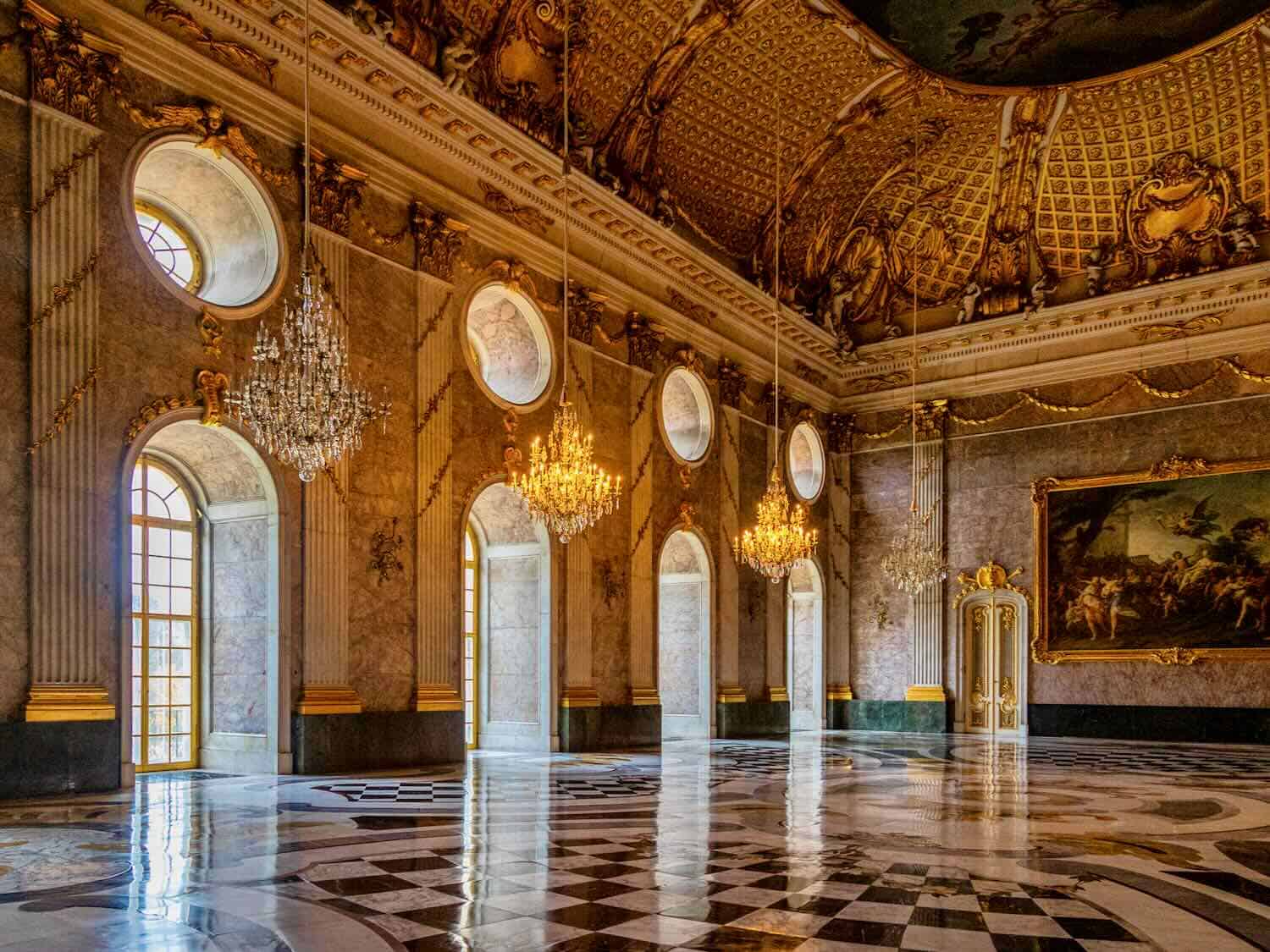
The ballroom stood out to me as a most luxurious setting. Later, William II, the last German emperor, and his family used the New Palace as their preferred place of residence.
After the German Revolution in 1918-1919, and the abdication of William II, the New Palace became a museum and remained so until the Second World War. The Soviet Army looted some of the palace’s treasures and much of its furniture was removed and taken to the residence of the exiled King in the Netherlands.
Most of the furnishings were discovered by the Dutch in the 1970s, still in their original packing crates, and returned to Potsdam. Because of this, and because it escaped bombing in the Second World War, the palace looks much like it did in 1918.
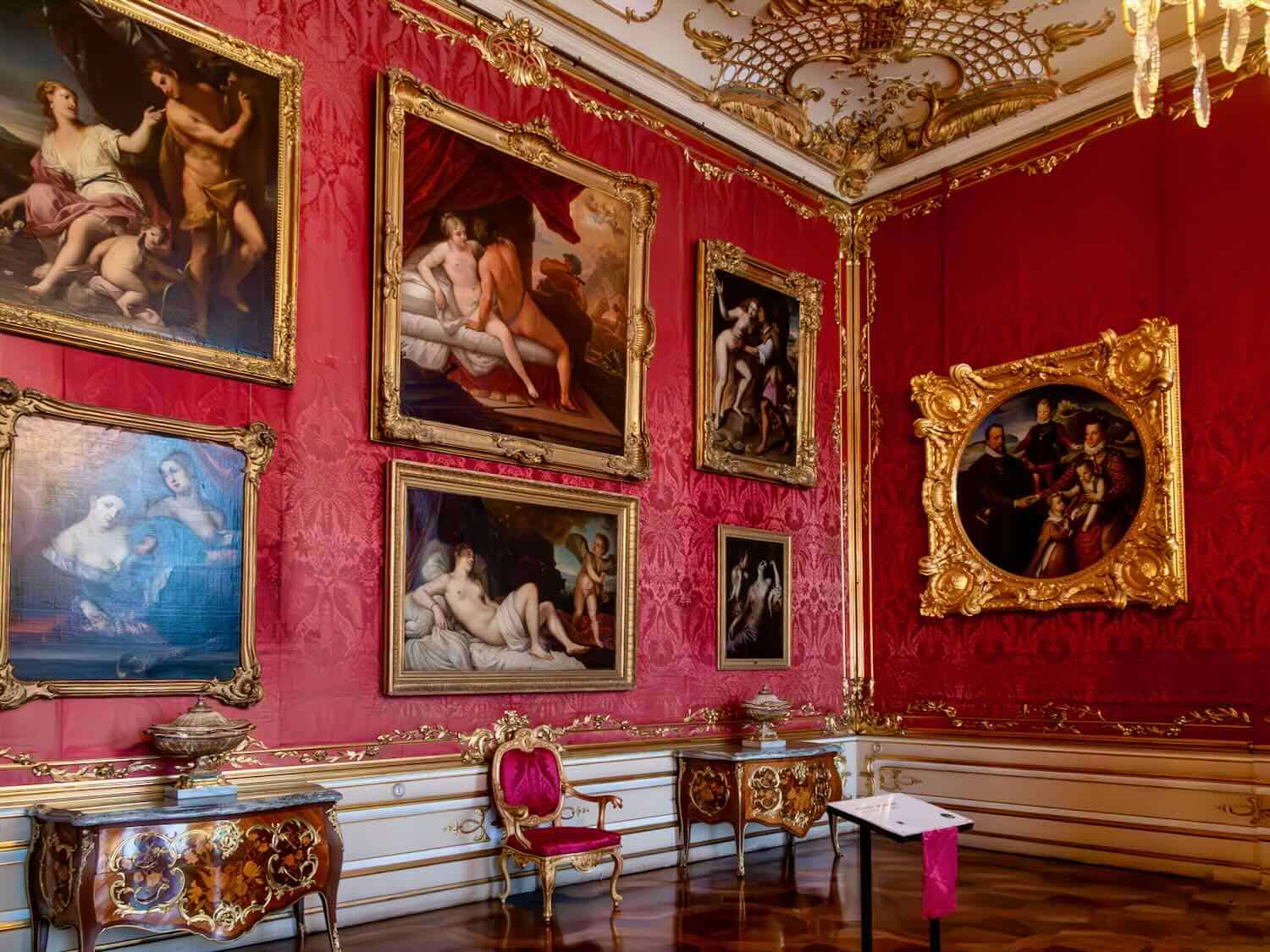
The tour did not include the main art galleries in the central section of the three-winged palace complex. Raphael Hall presents an impressive collection of more than fifty 19th-century copies of paintings by Raphael, including such well-known works as the Sistine Madonna and the Transfiguration. The red silk wall coverings add to the opulence and splendor of the paintings in their gilded frames.
The tour also did not include the theater in the south wing. The guide said the theatre lacks a royal box. Instead, Frederick would sit among his guests in the third row of seating from the stage. The semi-circular seat rows ascend as in a classical amphitheater. The theatre opened in July 1768 and remains in current use.
Stop for tea at the Chinese House
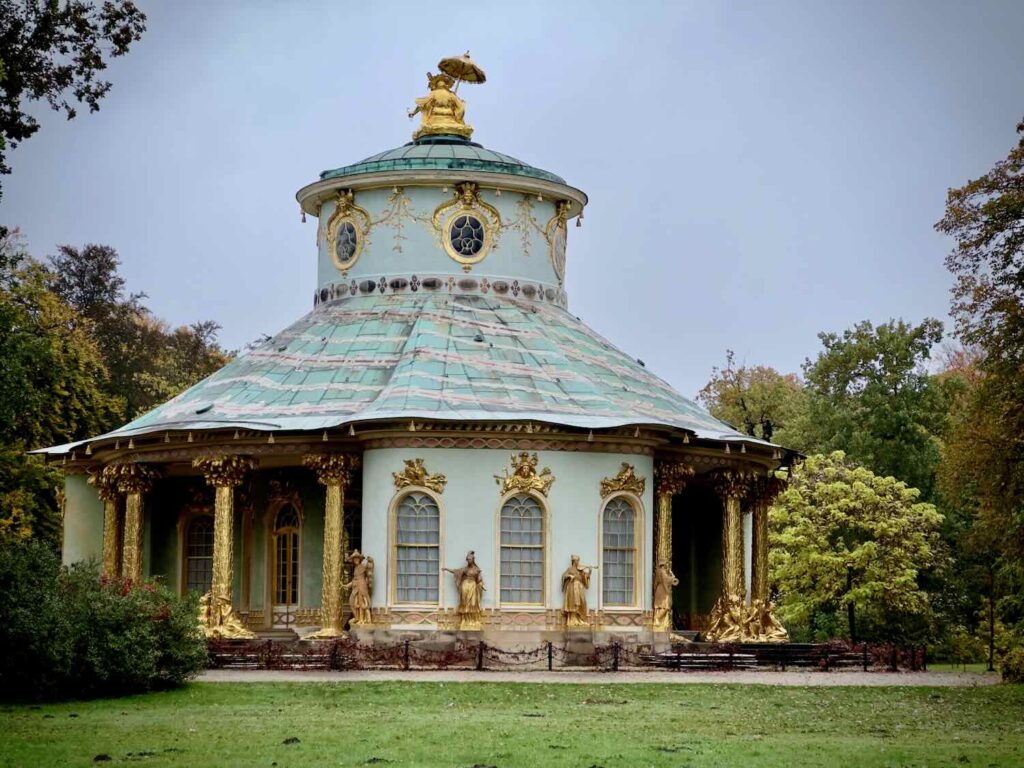
On our earlier walk, we passed the intriguing Chinese House. In the 18th century, the Prussian royalty had a marked admiration for oriental and Chinese cultures. So, Sanssouci Park has a Chinese Tea House and a Dragon House.
I took a few photos, but alas, I hope to return someday and go inside. During his stays at Sanssouci, Frederick the Great liked the intimate atmosphere of the Chinese House, which represented an escape to a fantasy world.
According to the brochure I bought, the Rococo pavilion is likely the most famous surviving example of the Chinoiserie fashion that influenced European court culture in the 18th century. However, it shows less of China as it was at the time compared to European ideas about it.
The pavilion’s exterior is distinguished by life-sized gilded figures placed around the building. Chinese musicians and tea drinkers, dressed in fairytale-like apparel, are represented.
Columns in the shape of gilded palm trees are meant to convey the impression that we are not in Europe. The large ceiling painting presents an exuberant “Chinese” social gathering depicted in an illusionistic architectural setting.
The ensemble was created between 1851 and 1864.
My travel companion and I wanted to see more, but our legs were too tired, so we headed back to the train station. Sanssouci is fabulous fun and absolutely worth a visit, and what we saw of the city of Potsdam made us very interested and curious to return.
I can’t leave out mentioning the Potsdam Conference, an important post-WWII event that had future consequences for Germany and international diplomacy.
Boomer Travel Tip
MedjetAssist Members who are hospitalized 150 miles from home receive medical transport to a home-country hospital of choice. Memberships from $99.
Potsdam Conference
History buffs will surely recognize the name Potsdam from a famous meeting held there after WWII. The Potsdam Conference was held in the Soviet occupation zone from July 17 to August 2, 1945, to allow the three leading Allies to plan postwar peace while avoiding the mistakes of the Paris Peace Conference of 1919. The participants were the Soviet Union, the United Kingdom, and the United States.
The Big Three—Soviet leader Joseph Stalin, British Prime Minister Winston Churchill (replaced on July 26 by Prime Minister Clement Attlee), and U.S. President Harry Truman—met in Potsdam, Germany, to negotiate terms for the end of World War II. The three most pressing issues discussed at Potsdam concerned how to handle a defeated Germany, the fate of Poland, and the final destruction of Japanese military power.
Questions dealing with German reparations, the economic rehabilitation of Germany, Poland’s postwar borders, and the composition of Poland’s government proved to be the most contentious. Even though the three heads of government had already agreed to jointly occupy Germany after the war ended, they still needed to formulate policies governing the administration of Allied occupation and the conditions of German surrender.
Questions about the extermination of Nazi elements, the reformation of German political institutions, the regulation of economic affairs, and the reparations were all questions that needed answers at Potsdam. While the Potsdam conference did not answer all the questions, it did establish a basis for maintaining war-born unity. It provided a basis for the early restoration of stability in Europe.
If you visit Berlin, be sure to plan a day trip to Potsdam and Sanssouci.
Hand-drawn sketch by Frederick II for Sanssouci Palace, 1744 (lost since 1945)

